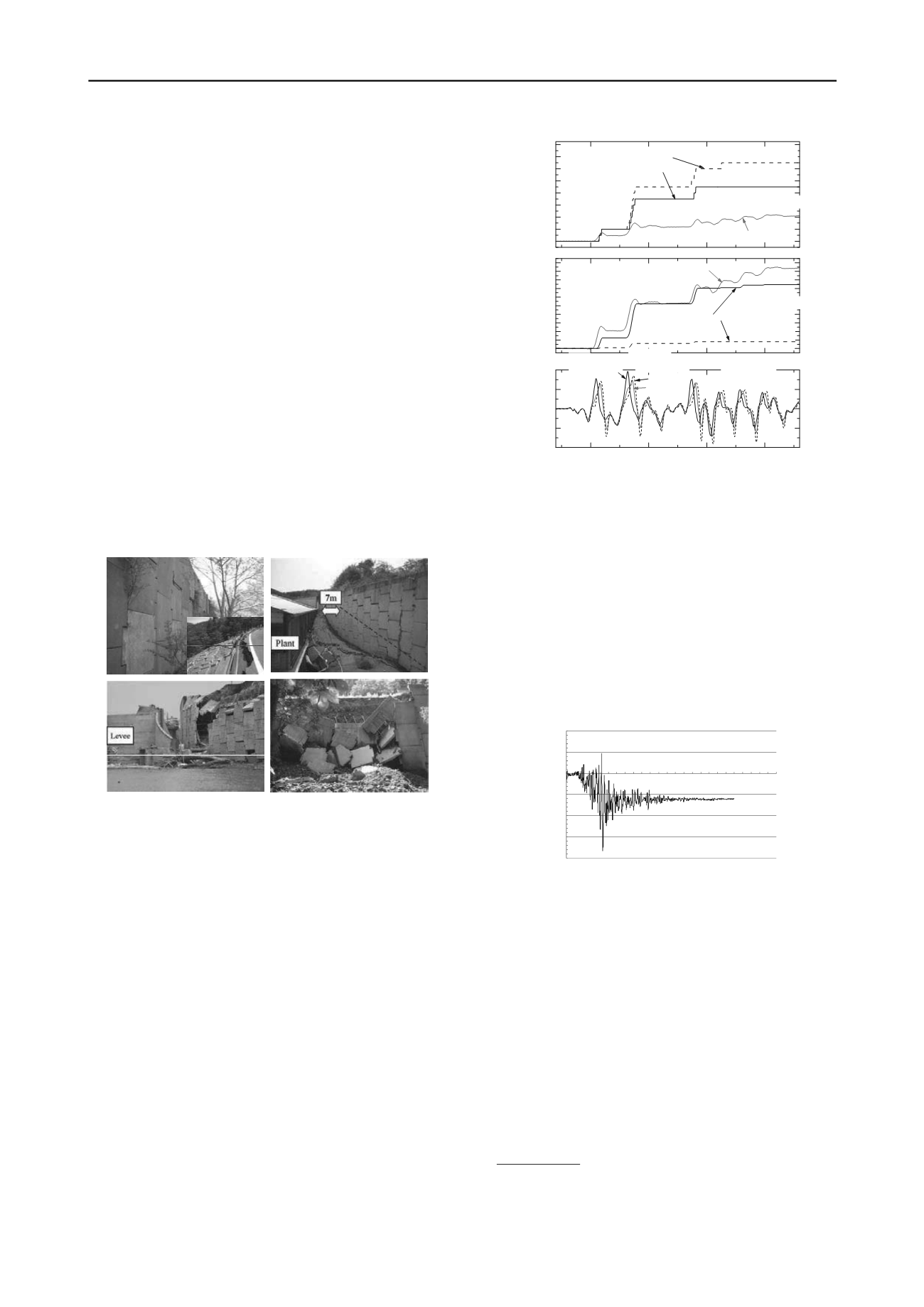
1405
Technical Committee 203 /
Comité technique 203
Two more case studies of failure mechanisms occurring
along soft-stiff soil interfaces, although not relevant to
earthquake loads, are described by
Rangel-Núñez et al.
(Mexico) and
Johansson et al.
(Norway).
The first paper describes a ‘Pioneer application of a dynamic
penetrometer and boroscope in archeological prospecting’ of a
heterogeneous fill covering a tuff pyramid, showing
deformation and cracking induced by man-made excavation and
environmental processes. FEM analyses proved the existence of
a mechanism of plastic/creep sliding along the underlying tuff.
The second contribution investigates the ‘Impact of blast
vibrations on the release of quick clay slides’ through empirical
attenuation laws of PGV and numerical simulations of rock
blasts near quick clay deposits. Cyclic loading contour diagrams
based on CTX tests were used for simplified estimates of
threshold vibration velocities inducing local slope failure.
6 RETAINING STRUCTURES
Otani et al.
(Japan) describe a comprehensive ‘Investigation of
Reinforced Earth in the 2011 off the Pacific coast of Tohoku
Earthquake’, presenting damage statistics as well as detailed
site-specific surveys. Only 4 out of the 1419 surveyed walls
showed full collapse mechanisms (Fig. 23), attributed to: (a)
inadequate drainage and earthfill material, (b) slippage on soft
foundation soil, (c) scouring (bottom erosion) due to the wash
away of an adjacent levee by the tsunami, and (d) weakness of
strip-panels connections due to prior frost-heave.
(a)
(a)
(b)
(b)
(c) (d)
Figure 23. Observed failure (a) and contours of maximum shear strain
predicted by FEM (b) and MPM (c) analyses (
Abe et al.
).
Watanabe & Koseki
(Japan) propose a ‘Seismic design of
retaining wall considering the dynamic response characteristic’.
The purpose was to predict displacements of railway-supporting
gravity walls more accurately than following the previous
standard procedure, based on a pseudo-static approach relying
on a ‘constant energy law’. The new design method applies the
Newmark (1965) model considering the combination of sliding
and overturning modes, defined by the yield surface of bearing
capacity in terms of horizontal force – moment relationship. The
approach predicted displacements and rotations in fair
agreement with those recorded in shaking table tests (Fig. 24)
and observed on a damaged railway cantilever wall after the
1995 Hyogo-ken nambu earthquake. In 2012 the proposed
method was therefore adopted in the new performance-based
design Japanese standard for railway retaining structures.
5.5
6.0
6.5
7.0
1000
500
0
-500
-1000
(Outward Inertia)
Inward Acc.
backfill
walltop
acceleration
acceleration
↑
Acceleration(gal)
Time(sec)
0
2
4
6
8
10
12
14
16
18
20
overturning mode
sliding and
sliding mode
Newmark method
Measured displacement
Horizontal displacment
at the bottom(mm)
0.00
0.02
0.04
0.06
0.08
0.10
0.12
0.14
0.16
Response
Base
overturning mode
sliding and
overturing mode
Newmark
method
Response rotational
angle (rad)
Measured angle
Figure 24. Wall response in shaking table tests vs. predictions by
Newmark analyses with different failure modes (
Watanabe & Koseki
).
Xiao et al.
(USA) investigate on ‘Seismic responses of
geogrid reinforced wall with Tire Derived Aggregates (TDA)
backfill using reduced-scale shake table test’. This lightweight
deformable recycled material was preliminarily characterized by
laboratory large scale tests, then used to build a geogrid
reinforced wall model overlying a thin sand layer resting on the
table floor. The model, shaken by a Loma Prieta earthquake
record, showed negligible relative base displacements while
those at the top were characterized by significant elastic
rebound (Fig. 25), not predictable by the rigid block model.
Notwithstanding the limitations of both the scaling laws and the
rigid base conditions, the Authors are encouraged to try FEM
analyses for reliable interpretation of test data.
-8
-6
-4
-2
0
2
4
0
10
20
30
40
5
Displacement (cm)
Time (sec)
0
Figure 25. Top displacement recorded in a shaking table test on TDA
geogrid reinforced wall (
Xiao et al.
).
7 DISCUSSION AND CONCLUSION
All the contributions to this Technical Session were perfectly
aligned with the main conference theme: ‘Challenges and
innovations’ are a strong commitment for earthquake
geotechnical engineering.
From the bulk of the papers presented, it is apparent that
advanced experimental techniques for cyclic and dynamic
testing on soils are getting increasingly widespread in all
countries. Some national scientific communities are
progressively bridging the gap with the traditionally leading
countries, U.S. and Japan above all, taking profit of their well-
established expertise.
The writer wishes to address some final comments as well
as suggestions for discussion and future research developments.
Field testing: practice in earthquake geotechnical
engineering is achieving increasingly beneficial contributions
from geophysics, especially in non-invasive techniques, such as
surface wave methods. More effort should be devoted to in-situ


